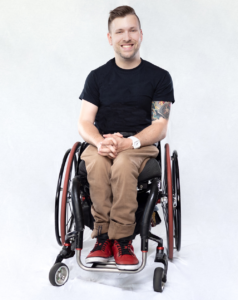How to Create Accessible Workplaces in 2020
It’s 2020 – the start of a new year, a new decade and an opportunity to create real change in the work that we do.
Last year, there were some incredible achievements in the areas of diversity and inclusion; with the introduction of the first-ever Accessible Canada Act (Bill C-81). Although this will initially only impact federally-run organizations and services, it’s an opportunity for all businesses to reflect on how they can be more inclusive – not just in the physical spaces in which we work, but also, how we go about hiring individuals, the accommodations we provide and the overall culture we create.
As an accessibility consultant, I can tell you that one of the biggest barriers to employment, especially for those who identify with having a disability, is actually attitudes. That’s right, attitudinal barriers are among the top reasons why some individuals with disabilities have difficulties finding work.
In fact, a Deaf woman in the UK claims she has “applied for over 1,000 jobs in 18 months – and was rejected from them ALL.” So why is this the case?

Marco Pasqua will be speaking at the HR Conference & Expo in Vancouver, B.C., April 28-29th.
I believe it comes down to misconceptions. The word “disability” is often associated with “disadvantaged” and if a person declares on their resume or cover letter that they have a disability, many questions can arise for employers, such as:
- How will this impact their work?
- Is accommodating to their needs going to be too difficult?
- And of course, how much is it going to cost?
From an employer’s perspective, these are all valid questions, however, as a person with a disability myself, I can tell you that having a diverse workforce, one that includes people with disabilities, can actually positively impact your bottom-line and some of your competitors might already be one step ahead of you. Companies like Microsoft, SAP and the Vancouver Airport recognize why hiring people with disabilities is good for business and that doing so, can provide access to over half a million candidates in British Columbia alone.
What Can Your Organization Do?
The good news is, it’s not too late for your organization to access this often untapped talent pool and I have 5 tips (many which cost little to no money) that can get your organization started today:
- Set the tone at the top: Whether you’re a small, medium or large-size business, work with your leadership team to set a top-down commitment and vision for an accessible and inclusive workplace using strategies and policies. Showcase your inclusive strategy and approach on your website and public-facing materials. Microsoft has begun several initiatives to help people with disabilities use its products, inspired in part by CEO Satya Nadella’s son Zain, who happens to have Cerebral Palsy.
- Review Your Hiring Policies and Job Application Process: Do you have a Diversity and Inclusion Statement? Are your job applications accessible to screen readers? These are just a few things to consider when creating inclusive job postings. Review your postings to ensure they are not unintentionally screening out a person with a disability just by the language you’re using.
- Provide Disability Awareness Training: This can be done through an external service or introduced through internal employee resource groups / lunch and learns. In some cases, you might even have an employee with a disability who is willing to come forward and share their story (just make sure you ask them first.)
- Offer workplace accommodation support: Every team member has different needs. Providing accommodations like desks that are adjustable in height, task lighting for those who may have low-vision or specialized software to assist in job duties often costs very little, but can have a big impact on productivity. A great organization to partner with here in B.C. is the Neil Squire Society, who offer a number assistive services including worksite accommodations recommendations. When in doubt, ask your colleague directly how you can best assist them.
- Create barrier free pathways and aisles: Ensure all major pathways in key areas/functions of your workplace are clear of obstacles. Regardless of a person’s abilities, it is nice to know that there aren’t any tripping hazards. If you’d like a full-assessment of your workspaces built-environment, I’d recommend your organization get assessed by the Rick Hansen Foundation Accessibility Certification™ (RHFAC) Program which goes above and beyond building code standards.
- *BONUS* Use large print and photos in documentation and signage: Provide documents (both internal and external) with alternate print sizes (at least 18pt font for printed materials and signage with at least a 72pt font). This size is easier to read, especially using sans-serif font types (e.g. Verdana, Arial.) If you’re an Office 365 user, there are also several new accessibility features including automatic live-captioning and accessible presentation templates in PowerPoint. This is ideal for individuals with low-vision and will also accommodate employees and customers who may be Deaf. Adding photos (with alt-text) and other visuals cues will also make it easier for employees or customers who would benefit from the use of picture symbols instead of letters and numbers.
I hope these tips provide you some insights on how your organization can become a leader in the area of accessibility and inclusion. If you are only able to implement one or all of them, the key is to simply get started because hindsight is 20/20.
Marco Pasqua will be speaking at the HR Conference & Expo in Vancouver, B.C., April 28-29th. For info on his session, titled, BC 2028: Are You Ready? CLICK HERE.
Marco Pasqua is an award-winning Entrepreneur, Accessibility Consultant and Inspirational Speaker. Advocating for universal design and inclusion is among his passions. He went in pursuit of a career in technology and after graduating from the Art Institute of Vancouver, he spent 5 years in the video game industry. During the recession of 2010, he lost his job, which turned out to be the biggest blessing in disguise. Marco decided it was time to use his voice to make a positive impact on the world, so he built his own brand as a professional speaker and entrepreneur. Throughout his life, Marco has been involved with a number of organizations as a spokesperson, helping to spread advocacy for persons with disabilities across Canada.
For the latest HR and business articles, check out our main page.
Reader Feedback
We want to hear from you!
Do you have a story idea you’d like to see covered by PeopleTalk?
Or maybe you’ve got a question we could ask our members in our People & Perspectives section?
Or maybe you just want to tell us how much you liked the article.
The door is always open.









